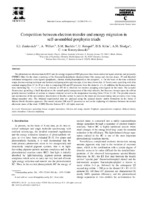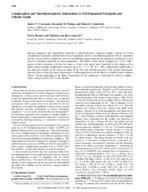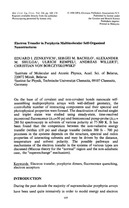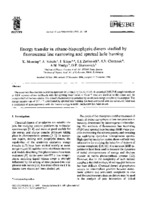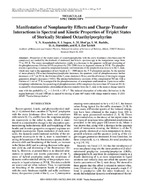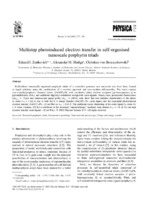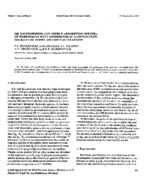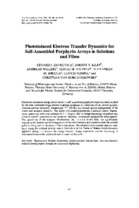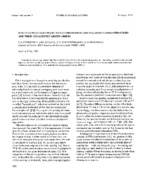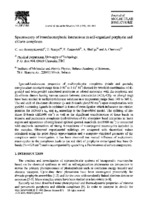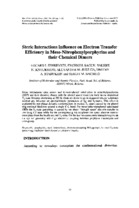Browsing by Author "Shulga, A. M."
Now showing items 1-14 of 14
-
Competition between electron transfer and energy migration in self-assembled porphyrin triads
Zenkevich, E. I.; Willert, A.; Bachilo, S. M.; Rempel, U.; Kilin, D. S.; Shulga, A. M.; Borczyskowski, C. von (2001)The photoinduced electron transfer (ET) and the energy migration (EM) processes have been studied in liquid solutions and polymeric (PMMA) films for the triads consisting of the Zn-octaethylporphyrin chemical dimer (the energy and electron donor, D) and dipyridyl substituted tetrapyrrole extra-ligands (porphyrins, chlorin, tetrahydroporphyrin) as the acceptors, A. On the basis ...2017-05-26 -
Complexation and interchromophoric interactions in self-organized porphyrin and chlorin triads
Chernook, A. V.; Shulga, A. M.; Zenkevich, E. I.; Rempel, U.; Borczyskowski, C. von (1996)Spectral properties and equilibrium constants of multimolecular complexes (triads) formed by 2-fold coordination of dipyridyl-substituted free bases of porphyrin, chlorin, or tetrahydroporphyrin with Zn-porphyrin and Zn-chlorin dimers bridged by either of two different spacers between the monomeric entities have been studied in methylcyclohexane at room temperature. The ability ...2017-05-18 -
Electron transfer in porphyrin multimolecular self-organized nanostructures
Zenkevich, E. I.; Bachilo, S. M.; Shulga, A. M.; Rempel, U.; Willert, A.; Borczyskowski, C. von (1998)On the base of of covalent and non-covalent bonds nanoscale self-assembling multiporphyrin arrays with well-defined geometry, the controllable number of interacting components and their spectral and photophysical properties were formed. The deactivation of excited singlet and triplet states was studied using steady-state, time-resolved picosecond fluorescence (∆½≈30 ps) and ...2017-05-25 -
Energy transfer in ethane-bisporphyrins studied by fluorescence line narrowing and spectral hole burning
Mauring, K.; Suisalu, A.; Kikas, J.; Zenkevich, E. I.; Chernook, A. V.; Shulga, A. M.; Gurinovich, G. P. (1995)The quasi-line fluorescence excitation spectrum of 1,2-bis (2,3,7,8,12,13,17,18-octaethyl-21H,23 H-porphino) ethane at 4.8 K consists of two subbands with the splitting mean value of 51cm⁻¹, that are ascribed to the donor and the acceptor half of the homodimer. The donor's fluorescence is quenched by an efficient energy transfer to the acceptor. The energy transfer rate of 10¹¹ ...2017-05-18 -
Identification and assignment of porphyrin-CdSe Hetero-nanoassemblies
Zenkevich, E. I.; Blaudeck, T.; Shulga, A. M.; Cichos, F.; Borczyskowski, C. von (2007)Hetero-nanoassemblies in toluene solution are formed via anchoring pyridyl substituted free base porphyrin molecules on the colloidal core-shell semiconductor nanocrystals CdSe/ZnS. The formation can be identified via quenching of semiconductor photoluminescence and followed via spectral changes of porphyrin spectral properties such as fluorescence, fluorescence decay and absorption. ...2017-05-27 -
Interaction of multiporphyrin systems with molecular oxygen in liquid solutions: Extra-ligation and screening effects
Sagun, E. I.; Zenkevich, E. I.; Knyukshto, V. N.; Shulga, A. M.; Starukhin, D. A.; Borczyskowski, C. von (2002)Steady-state and time-resolved studies indicate that for a sequence of porphyrin or chlorin chemical dimers Zn-cyclodimer → (ZnOEP)₂Ph → (ZnOEP)₂ → (ZnHTPP)₂ → (ZnOEChl)₂ with relative lowering of excited S₁- and T₁-states, the extra-ligation by pyridine (PYR) does not influence essentially on fluorescence parameters but leads to an increase of T₁-states non-radiative decay (the ...2017-05-26 -
Manifestation of nonplanarity effects and charge-transfer interactions in spectral and kinetic properties of triplet states of sterically strained octaethylporphyrins
Knyukshto, V. N.; Sagun, E. I.; Shulga, A. M.; Starukhin, D. A.; Bachilo, S. M.; Zenkevich, E. I. (2001)Properties of the triplet states of octaethylporphyrins with the steric hindrance (free bases and Pd complexes) are studied by the methods of stationary and kinetic spectroscopy in the temperature range from 77 to 293 K. The mono-mesophenyl substitution results in a decrease in the quantum yield and shortening of the phosphorescence lifetime of Pd complexes by 250–3500 times in ...2017-05-26 -
Multistep photoinduced electron transfer in self-organised nano-scale porphyrin triads
Zenkevich, E. I.; Shulga, A. M.; Borczyskowski, C. von (2002)Well-defined structurally organised porphyrin triads of a controlled geometry andnanoscale size have been formed in liquid solutions using the combination of a covalent approach and non-covalent self-assembly. The triads contain zinc-octaethylporphyrin chemical dimer, (ZnOEP)₂Ph, with covalently linked electron acceptors (p-benzoquinone, Q or pyromellitimide, Pim), and additional ...2017-05-26 -
NH-tautomerism and visible absorption spectra of porphyrins with nonsymmetrical substitution: oscillator model and mo calculations
Zenkevich, E. I.; Shulga, A. M.; Filatov, I. V.; Chernook, A. V.; Gurinovich, G. P. (1985)On the basis or experiments Ihe oscillator model has been established for individual NH tautomers or porphyrins with asymmetrical substitution. CNDO/2 calculations explain the inversion of Q ₓ (O.O) and Q y (O.O) electronic transition intensities in NH tautomers as a consequence of the inversion of LUMO coefficients c₁ and c₂ for fixed x and y molecular oscillators.2017-05-18 -
Photoinduced electron transfer dynamics for self-assembled porphyrin arrays in solutions and films
Zenkevich, E. I.; Kilin, D. S.; Willert, A.; Bachilo, S. M.; Shulga, A. M.; Rempel, U.; Borczyskowski, C. von (2001)Electronic excitation energy deactivation in self-assembled porphyrin triads has been studied by the time correlated single photon counting technique as a function of the solvent polarity (toluene-acetone mixtures), temperature (77-350 K), and mutual spatial arrangement of the donor and acceptor subunits. The donor (Zn-octaethylporphyrin chemical dimer) fluorescence quenching ...2017-05-26 -
Self-assembled nanoscale photomimetic models: structure and related dynamics
Zenkevich, E. I.; Borczyskowski, C. von; Shulga, A. M.; Bachilo, S. M.; Rempel, U.; Willert, A. (2002)Using static and time-resolved measurements, dynamics of non-radiative relaxation processes have been studied in self-assembled porphyrin triads of various geometry, containing the main biomimetic components, Zn–porphyrin dimers, free-base extra-ligands (porphyrin, chlorin or tetrahydroporphyrin), and electron acceptors A (quinone or pyromellitimide). The strong quenching of the ...2017-05-26 -
Spectral Рeculiarities of NH-Tautomerism in Isocycle-Containing Porphyrins and their Covalently Linked Dimers
Zenkevich, E. I.; Shulga, A. M.; Chernook, A. V.; Gurinovich, G. P. (1984)It has been found experimentally that a whole class of isocycle-containing porphyrins, including synthetic and natural objects and their covalently linked dimers, shows NH-tautomerism which manifests itself in isotropic solutions in normal electronic spectra both at 77 K and higher temperatures (up to 500 K).2017-05-18 -
Spectroscopy of interchromophoric interactions in self-organized porphyrin and chlorin complexes
Zenkevich, E. I.; Shulga, A. M.; Chernook, A. V.; Rempel, U.; Borczyskowski, C. von (1995)Spectral-luminescent properties of multimolecular complexes (triads and pentads, complexation constants range from 5∙10⁶ to 5∙10⁷ M⁻¹) formed by two-fold coordination of dipyridyl and tetra-pyridyl substituted porphyrin or related molecules with Zn-porphyrin and Zn-chlorin dimers having various spacers between macrocycles (-CH₂-CH₂- or phenyl ring) have been studied in methylcyclohexane ...2017-05-18 -
Steric interactions influence on electron transfer efficiency in meso-nitrophenylporphyrins and their chemical dimers
Knyukshto, V. N.; Zenkevich, E. I.; Sagun, E. I.; Shulga, A. M.; Starukhin, D. A.; Bachilo, S. M. (2001)Steric interactions upon mono- and di-meso-phenyl substitution in octaethylporphyrins (OEP) and their chemical dimers with the phenyl spacer manifests itself in the dramatical T₁-state lifetimes shortening at 293 K (from ms down to μs in degassed toluene solutions) without any influence on spectral-kinetic parameters of S₀- and S₁-states. This effect is explained by non-planar ...2017-05-26

